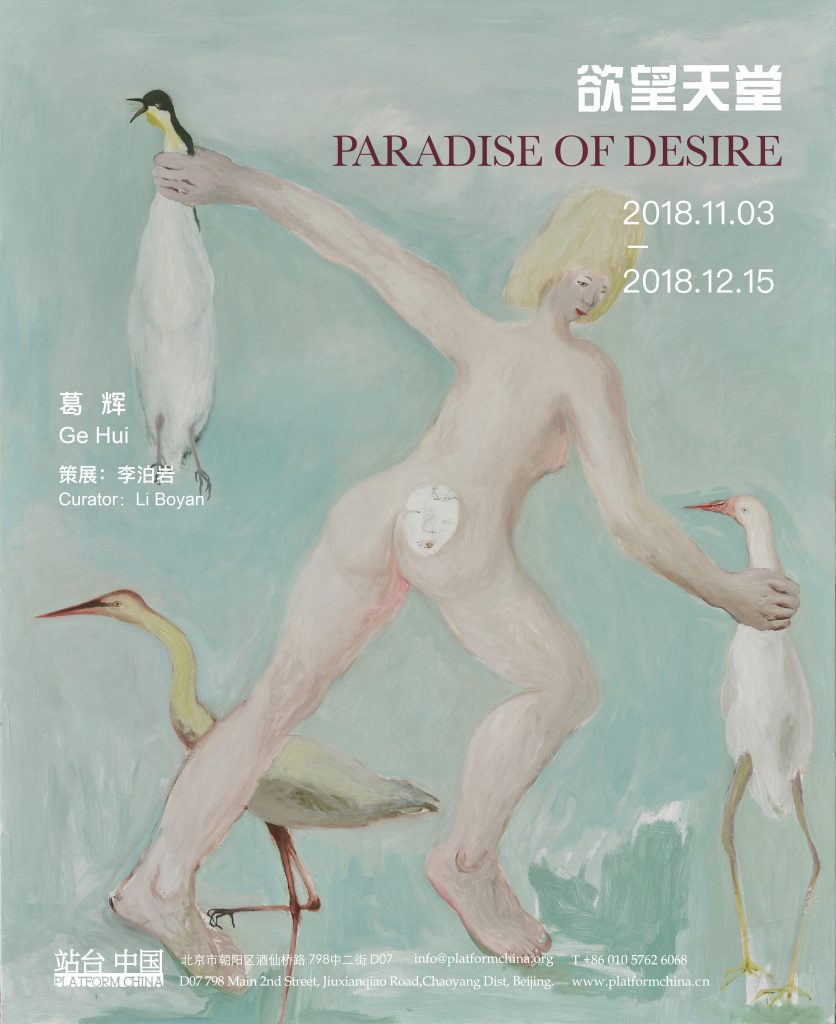PARADDISE OF DESIRE-Ge Hui Solo Exhibition
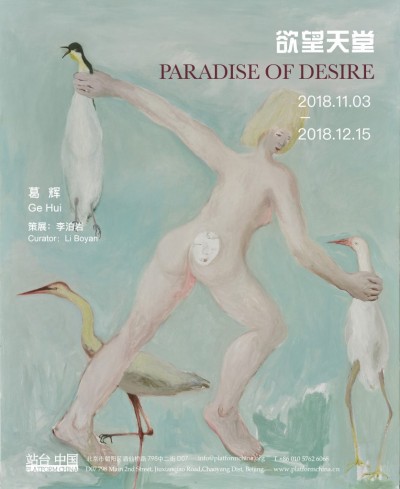
葛辉|欲望天堂
PARADDISE OF DESIRE - Ge Hui Solo Exhibition
展览地点 :站台中国当代艺术机构(北京朝阳区酒仙桥路2号798艺术区中二街D07)
策展人 :李泊岩
展览周期 :2018.11.03-2018.12.15
Venue:Platform China Contemporary Art Institute (D07 Main 2nd Street, 798 Art District, No.2Jiuxianqiao Road, Chaoyang District, Beijing,China)
Curator:Li Boyan
Duration:2018.11.03-2018.12.15
只有理性的幻想才是艺术的真谛。——戈雅
艺术家未必会蓄谋超越经典,然而某些时刻,艺术实践的经验会在臆想中乱撞,将一些不可名状的感知和幻想浮现出来。在展出的17件作品中,我们看到一个由欲望构建起来的荒芜,在一个个体生命中,延续着艺术的本真。所谓"欲望",正是葛辉画作中那些人形的昭然若揭,或是欲盖弥彰的风流仪态,一种不属于任何阶层的扭捏或是端庄。而"天堂"正是"欲望"肆意流动,模糊时空的温床,是欲言又止的呓语,也是对生命最初的想象。葛辉用疏离而荒诞的方式塑造出一个个构架充盈的形体直指理性背后的荒芜。这些在手舞足蹈的拉扯中结束,在悬而未决的冥想中搁笔,在男欢女爱的欲望中终了,在全部仍可以称为未完成的状态中完成的作品,被笼罩在一个恍惚的梦境中。
戈雅一方面相信理性的存在,一方面看不到理性的方向,他晚年说出:“只有理性地幻想才是艺术的真谛。”正是受到启蒙思想中“理性”的召唤而发出的感言。戈雅在理性的控制中,将教宗画成魔鬼,将权贵画成动物,在他的画中充满粗旷、失落和不安。他在宗教社会里对自己的艺术路径别无选择,却在内心极力释放着自己的欲望。从戈雅开始,个人情绪的表达逐渐从“美化对象”转变为“理性幻想”。
葛辉生活在一个经历了漫长文化整合期仍没有结果的年代。他在既有系统和谱系的视线范围之外,自然生长,并自定义自己的逻辑和审美。在葛辉作品中,人物通常取材于生活,却难以分辨出身份,这些或卧,或侧躺,或席坐,或纠缠在一起的人……有着明显的对物写生的感觉。但所有的细节,几乎都很难确认他们是否是同一个人。葛辉在理性的控制中,将他们画成了一个属于“人”这个符号的轮廓。我们可以理解为,这是一个从现实到大脑的隐性传输,不断将人物身份从具体过渡到散漫。这也不可避免地将观众卷入对于观看身份的质疑中去,一种光明正大的“理性臆想”通过画面布置,激荡着观众的观看“欲望”。
不妨借用葛辉自己说的一句话:“梦中的事物都是恍惚的,可以变幻的,只能以欲言又止的方式呈露出来,也是回到生命最初想象。梦中的呓语,只有当生命处于余外状态时才能倾听得到。”我们可以将这句话理解为一句诗,这是艺术家极力将自己去身份化再重新审视自己的表达。他将自己看作不属于任何时代的自由人。这一打破僵局的本能,成为蕴藏在他身体里和戈雅对于艺术“原初状态”的基因纽带。
形状的边缘,是葛辉绘画最达意的要素;形像清晰,思想模糊,则是葛辉绘画的潜在特征。葛辉的绘画,在模棱两可的想象中周旋,他在确认真实,确认某种最自然的原初形状。这种原初状态从何而来呢?福科说:“人们要在绝对隐私的地方,提出这些最隐私的问题。”葛辉将自己自觉地放置在“绝对隐私”的处境中,在漫长的时间里,不断自问真相何在?因此,葛辉通常在一幅画面前反复调整,反复打磨,反复将自己逼到最隐私的处境中去。
在作品《三十六枝花》中,我们可以看到未完成的效果,一团荆棘围绕的玫瑰凸显在画面的最前面,远处一个姿态尚不明了的人体形状,引人联想。内容的位置与笔触在空间层次上集合起来,类似音乐式的线性结构,完全与古典造型拉开了距离。《娇羞的,太娇羞的》这两件同名的大尺幅作品,有着明显的戈雅式的辛辣作派,那种对艺术无限的解放,和对于人性纠葛的个人判断,形成了一个统一的类似舞台的平面空间。葛辉在尽可能同化梦境的视觉循环,那些看似潦草的,断断续续的,颜色混淆的色块儿背后,是葛辉理性的驾驭。在葛辉的手里,一手握着神秘,一手握着浪漫,因为有了神秘和浪漫,“欲望”像诗句一般自由地跳跃在他的意识流中。在意识流的幻想下,如《从来就没有准备一则故事》等作品,有着明显的去故事化的目的。那些琢磨不透的,难以形容的内容,以及复杂的表情,和相互依靠的肢体,都指向人性的纠葛。时而出现的动物,显得安静,狮子与人和平的共处,白鹅被女人开心的轻松拎起,他们在一起充满戏虐的荒诞感。
“天堂是什么颜色?”“天堂是肉粉色的。” 肉粉色的躯体凝视着观众,隐隐地透出不安的征兆。“欲望天堂”,既属于一个躯体的符号轮廓,也属于一个梦境的反复叠加。在不堪重负的崩塌之时,形象出现了——野蛮的巨人、空虚的男人、娇羞的女人,他们不再属于任何阶层,也不说明任何苦难或欢愉。他们在迎接和等待着什么,或是作出了一个永不再有交流的决定。那种野蛮的生长,自由的胜利和伟大的无知,都可以借用葛辉的艺术诉说这一精神的脉络。并在这些散漫的轮廓下,招摇地展示出陌生经验的凯旋。那种通过欲望本能诉说出来的东西,不就是天堂吗。

娇羞的,太娇羞的 Shy, too shy; 布面油画 Oil on canvas, 200x300cm ,2018

娇羞的,太娇羞的 Shy, too shy;布面油画 Oil on canvas,200x300cm ,2018

三十六支花 Thirty six flowers,布面油画 Oil on canvas,250x300cm ,2016-2018
“Only rational fantasy is the essence ofart" -- Francisco José de Goya y Lucientes
The artist may not intend to transcend the classics, while the experiences of art practical collide in the imagination sometimes, and some indescribable perception and fantasy will arise. We see a desolation constructed by desire among 17 works in this exhibition, which continues the essence of art in life. The so-called "desire" is adissolute state which is showed obviously or without disguise on Ge’s painting.It is a kind of twist or dignity that not belongs to any class. While the"heaven" is just the place with flowing “desire”, the place likes a hotbed where time and space are vague, the word was said hesitantly in our dream and the initial imagination of life. Ge creates many plump bodies with alienated and absurd ways to represent the desolation behind logos. These works, which end in a flutter dance, in a long standing meditation, in a desireof flesh liness, and are finished in a state that is still called unfinished, are being shrouded in a fuzzy dream.
On the one hand, goya believed the existence of reason,on the other hand, he could not see the direction of It. In his later years, hesaid:" Only rational fantasy isthe essence of art " . This opinion are inspired with the "reason" in the enlightenment thought. Goya, with the control of reason, painted the religion as a devil and the bigwig as an animal, and his paintings are full of coarseness, loss and uneasiness. He had no choice about art in the religious society, while he wastrying to release his desire from his heart. Since Goya, the expression of personal emotions changed from "beautifying objects" to "rational fantasy" gradually.
Ge lives in an age that cultural was integrating but still doesn’t have any result in a long period. He grows naturally and builds his logos and aesthetic outside the sight of existing systems and spectrum. In his works, the figures which lie,lie on one side or sit down are usually drawn from life, but their identity isdifficult to be distinguished. It has strong sense of painting model. But it's hard to ensure ifall the details are belonging to one model. Under the control of reason, Gepainted them into an outline of the symbol "people". We can comprehendthat as an implicit transmission from reality to the brain and the identity of figures are shifted from specific to the random. This inevitably involved the audiencein the doubts about the viewing identity, while a kind of aboveboard "rational imagination"impacts the audience's "desire" of watching through the structure of painting.
We might as well use a sentence of Ge :“things are misty, changeable in the dream, which only can be presented hesitantly, and it’s also back to the original imagination of life. The delirium in dreams can only be heard when life is in an extra neousstate." This sentence can be seen as a poem and an expression of the artist trying to de-identify and relook himself. He saw himself as a freeperson who not belongs to any age. The instinct of breaking the stalematebecame a genetic link between his body and Goya's "original state" of art.
The edge of shape is the most significant element in Ge's painting, while the potential feature is clear figure and the fuzzy thought. Paintings swirl in ambiguous imagination. He confirms the truth and the most natural and original shapes.Where did the original state come from? Foucault said: "People ask the most private questionsin the most private places". Ge puts himself in the position of"absolute privacy", and keeps asking himself where is the truth for along time. So, Ge usually adjusts and polishes repeatedly in front of a picture, forcehimself into the most private situation repeatedly.
In the work "thirty-six flowers", we can seethe unfinished effect. The rose surrounded by thorns at the front of the picture, and a figure with an unclear posture is as sociative in the distance. The distribution of the content and brush stroke in the space is set up on the spatial gradation. The linear structure of it issimilar as music, and is completely separated from the classical style. Two large paintings named "shy, too shy" have obvious Goya's pungency style. The infinite liberation of art and personal estimate of contradictory human nature form a unified plane space like a stage. In trying to assimilate the visual cycle ofthe dream, Ge's rational control is behind those seemingly scrawled, intermittent and confused colors. He held mystery in one hand and romance inthe other, because "desire" leaped freely on the stream-of-consciousness, like a poem, when mystery and romance were hold. Under the illusion of stream-of-consciousness, there is a clear purpose of de-story in the works such as "never prepare astory". The impenetrable and ineffable content, the unpredictable expressions and the interdependent limbs, all point to contradiction of human nature. The animals in some paintings appear to be quiet, the lion and the people coexist peacefully, the white goose is picked up by the woman happily and easily, they are full of the absurd feeling and drama abuse when putted together.
“What’s the color of paradise?” “It’s flesh pink.” The bodies in fresh pink are staring at viewers dimly and uneasily. "Heaven of desire” not only belongs to an outline of bodily symbol, but also belongs to a complex superposition dream. When it breaks on account of overburdened, the figure starts to appear, thesavage giant, the inane man and bashful woman, they won’t belong to any class and it’s not a demonstration of any pine or joy. What are they waiting for? Or decideto don’t have conversations anymore. The wild growing, the victory of freedom and the great innocence, all can be state though borrowing Ge’s art. Also, itcould show unexperienced victory. What can be recounted with instinctively is paradise.
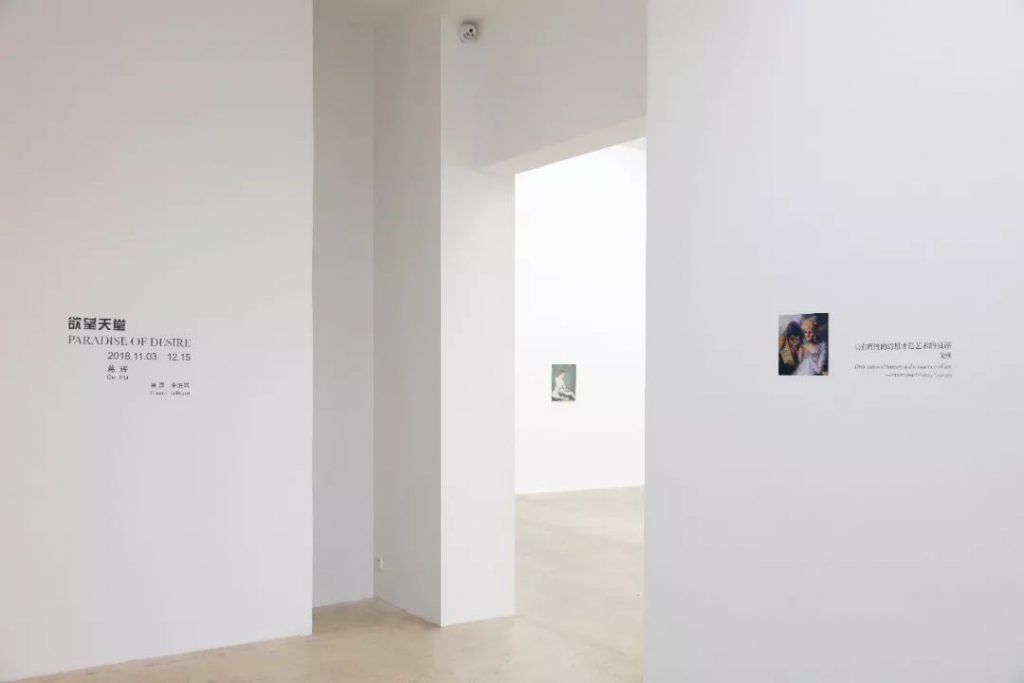
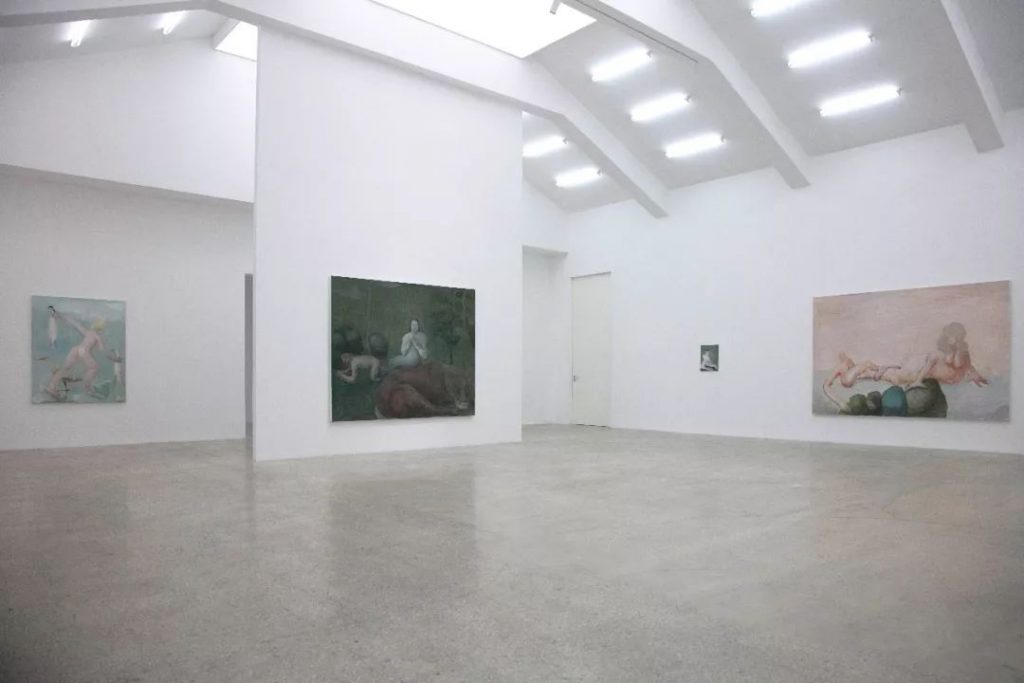
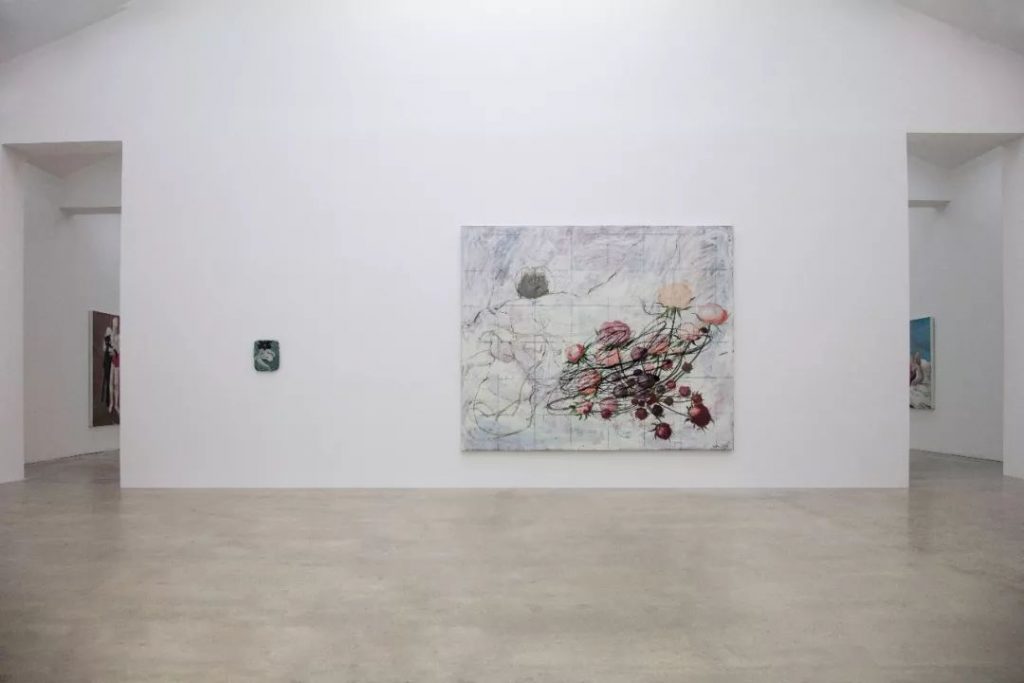
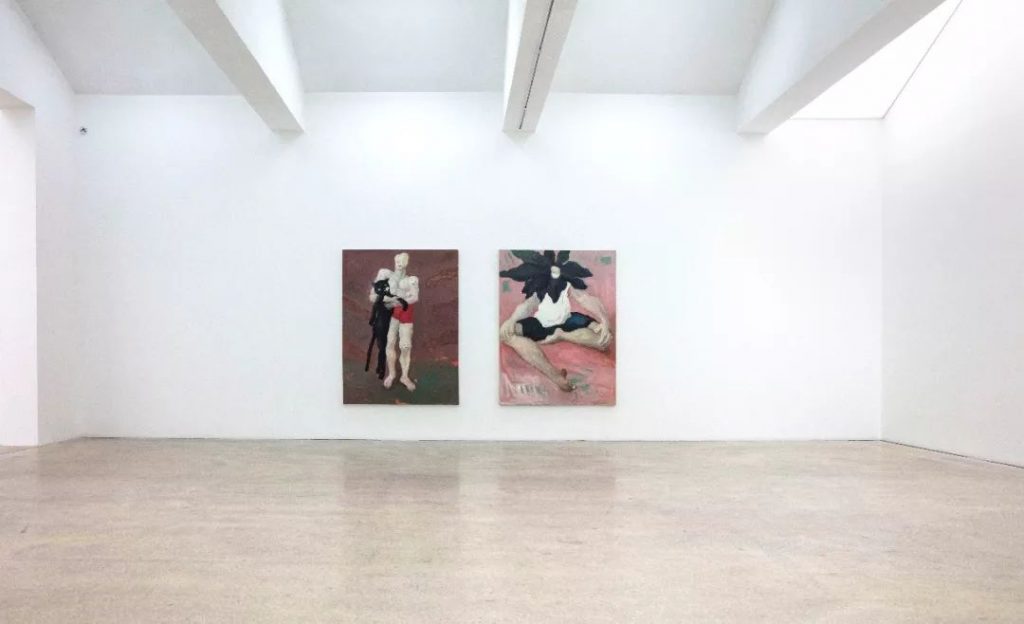

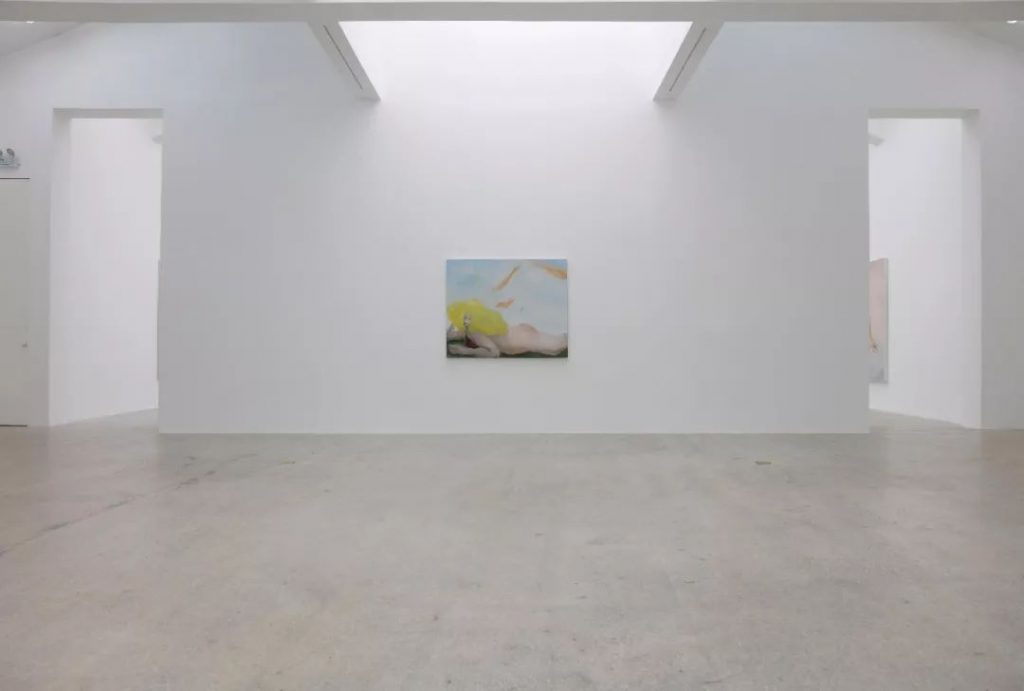
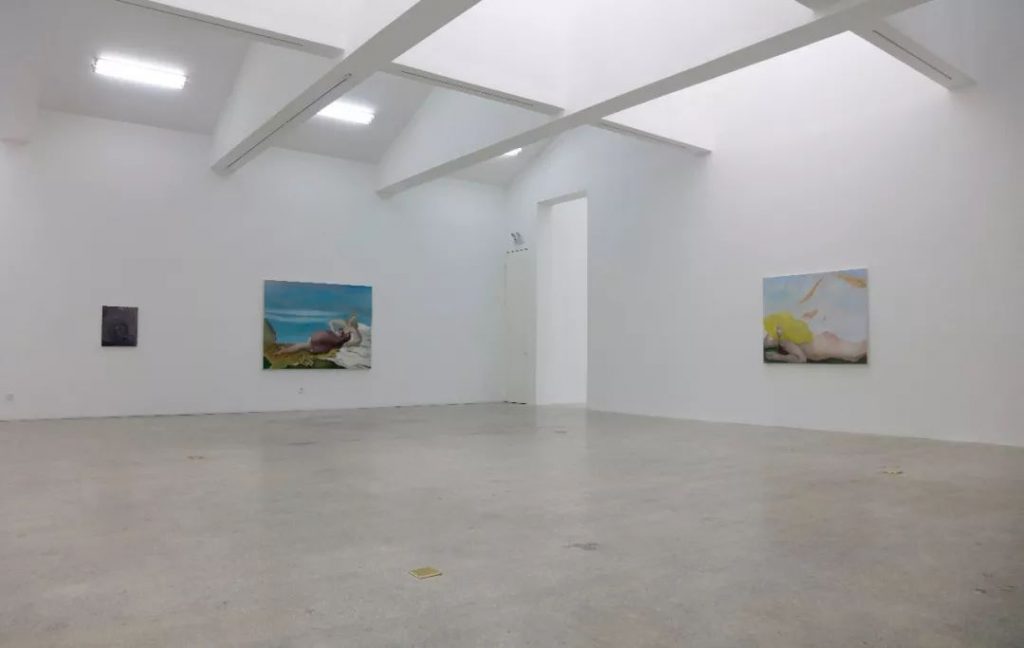
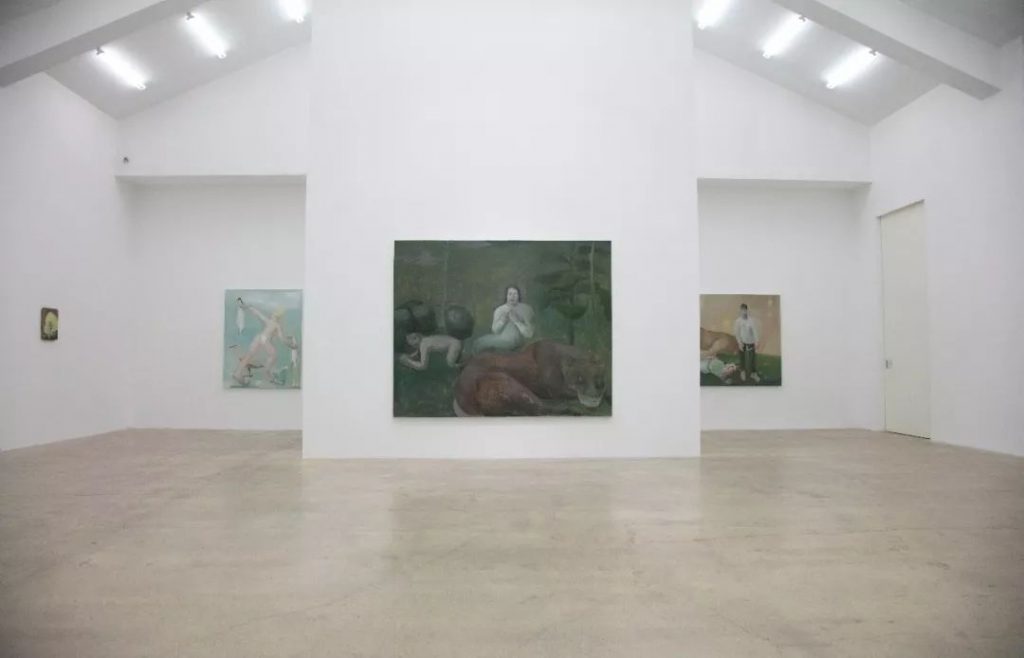
[关于艺术家]
葛辉, 1983年出生于江苏。部分个展:“欲望天堂”(站台中国,北京,2018),“诗一样顺滑”(LMT空间,上海,2016),“娇羞的,太娇羞的”(艺通佰通,上海,2015),“至此等待”(仟僖雅画廊,武汉,2014),“硬伤”(艺术创库,香港,2014),“至此等待”(索里卡艺术中心,哥本哈根,丹麦 2013),“能量继续迁徙”葛辉作品单元(巴黎市政大厅,巴黎,法国,2012),“梦幻乐园”(艺术创库,香港,2012),“春去春又来”(证大艺术馆,上海,2011),“暖回”(多伦现代美术馆,上海,2011),“敞视移情——可能性空间”(地平线艺术空间,上海,2010),“天真蓝”(苏州美术馆,苏州,2009)。近年参与美术馆项目:“同曦”中国国际装置艺术展(今日美术馆),“第二届中国装置艺术论坛暨首届国际装置艺术展”(龙美术馆),“各就其位-当代艺术中的自我建构”当代艺术展(多伦现代美术馆),“垚-从土地到家园的想象”当代艺术展(雨村美术馆),“一个非社会学研究的个案”当代艺术展(证大当代艺术空间),“印刷的快感”当代艺术展(多伦多安大略美术馆),“双城记”(多伦现代美术馆),“个命——走出经验的地带”当代艺术展(香港当代美术馆),中国新锐艺术大展(文轩美术馆)。
[About Artist]
GE HUI (b.1983),Solo exhibition: 2016,“smooth like a poem”(LMT, Shanghai,China); 2015, "shy, too shy" (Space (E) of China,Shanghai, China); 2014, "little shyness shortcomings Ge Hui soloexhibition" (Art library, Hong Kong, China);2013, "now wait Ge Hui solo exhibition" (linecard art center, Copenhagen, Denmark);2012, "the energy to continue migration" Ge Huiworks project city hall in Paris ( France, Paris), "Dreamland" (art library, Hong Kong, China);2011, The spring of 2011 "go to" (ZenDai museum of Modern Art, Shanghai, China), "Warm back” (Shanghai duolun of modern artShanghai, China);2009, "naive blue Ge Hui solo exhibition"(Suzhou art gallery, Suzhou, China). The Museum Project: “TONGXI” The 3rd China International Art Forum & Exhibitionon Installation Art (Today Art Museum), The 2nd China international Forum forart & China Exhibition for Art Installation(Long Museum), IN THEIR PLACESThe Self Construction in Contemporary Art (Shanghai Duolun Museum of Modern Art); YAO: The Imagination From Land To Homeland (Yucun Art Museum), A Non-Sociological Case Study( Zendai ContemporaryArt Space), "The Pleasures of Print " Contemporary Art Exhibittion (AGO), “Self-Destiny out of the land of experience” contemporary art exhibition ( HongKong Contemporary Art Museum, Beijing, China), “Da Tang Annual Chinese Aggressive Art Exhibition” (Winshare art investment organization).
more:
